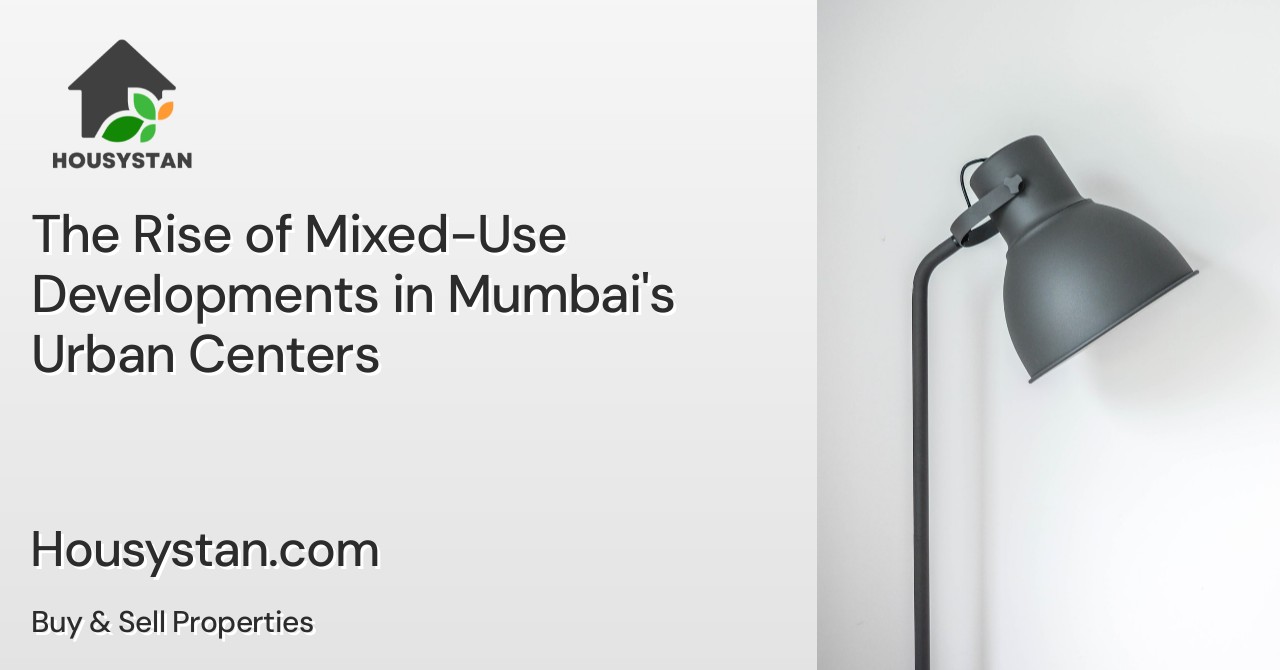The Rise of Mixed-Use Developments in Mumbai's Urban Centers
Read latest blogs and articles from Housystan

The Information mentioned here was last updated on:
31/12/2025The Rise of Mixed-Use Developments in Mumbai's Urban Centers
Mumbai, India's bustling financial capital, is undergoing a significant transformation. In response to rapid urbanization and population growth, the city is embracing mixed-use developments, a modern urban planning concept that integrates residential, commercial, and leisure spaces into one cohesive environment. This thriving trend is reshaping Mumbai's urban landscape and influencing how its inhabitants live, work, and play.
What Are Mixed-Use Developments?
- Verified Tenants/Buyers
- Unlimited Property Listing
- Zero subscription/charges fee
Mixed-use developments are versatile complexes that combine various types of spaces, such as:
- Residential Units: Apartments, condos, and sometimes serviced housing.
- Commercial Spaces: Offices, co-working areas, and retail shops.
- Recreational Facilities: Parks, gyms, pools, and entertainment centers.
- Cultural Venues: Art galleries, theaters, and community centers.
These developments are designed to be self-contained ecosystems where people can access all their essential needs within a short distance. The concept, while not new, is being increasingly implemented in Mumbai to address urban challenges.
The Growing Appeal of Mixed-Use Developments in Mumbai
Addressing Urban Sprawl
Mumbai's rapid growth has led to increased urban sprawl, causing longer commutes and overburdened infrastructure. Mixed-use developments offer a solution by minimizing the need for long-distance travel, thus alleviating traffic congestion and environmental impact.
Enhanced Lifestyle and Convenience
Residents of mixed-use developments enjoy unparalleled convenience. Living close to work, shopping, and leisure facilities means they save time on commuting, which improves the quality of life. The presence of green spaces and recreational areas within these complexes also promotes healthier lifestyles.
Economic Benefits
Mixed-use developments attract businesses and create jobs, boosting the local economy. By integrating commercial spaces, they encourage entrepreneurship and support small businesses. The increased foot traffic in these areas also benefits retail and dining establishments.
Sustainability and Smart Design
These developments are often built using eco-friendly materials and incorporate energy-efficient systems. They also encourage the use of public transport, cycling, and walking, contributing to a reduction in carbon footprints and making urban living more sustainable.
Key Areas in Mumbai Witnessing Mixed-Use Development
Lower Parel
Once known for its textile mills, Lower Parel has evolved into a trendy urban hub. It features iconic mixed-use developments like High Street Phoenix, offering a seamless blend of shopping, dining, and residential spaces. This area is a prime example of successful urban renewal.
Bandra-Kurla Complex (BKC)
BKC has rapidly developed into Mumbai's premier business district. It houses a mix of corporate offices, luxury hotels, and high-end residential spaces. The region's strategic planning has turned it into a vibrant destination for both professionals and residents.
Andheri East
An emerging center for mixed-use development, Andheri East offers a combination of affordable housing and business opportunities. Developers are focusing on creating integrated townships to cater to Mumbai's expanding population.
Trends Driving Mixed-Use Developments
Integration of Technology
Smart technologies are making these developments more efficient and user-friendly. From high-speed internet and smart home features to sophisticated security systems, technological integration is a major draw for residents and businesses alike.
Preference for Urban Living
There is a growing preference for urban living, especially among younger generations. People are increasingly favoring accessible and vibrant neighborhoods that align with their lifestyles. Mixed-use developments cater to this demand by offering dynamic communities.
Adaptation to Post-Pandemic Realities
The COVID-19 pandemic highlighted the need for integrated living spaces. With the rise of remote work, people seek homes that offer more than just residential comfort. They desire access to office amenities, green spaces, and leisure facilities within their community.
Challenges and Considerations
High Costs
Developing mixed-use projects involves significant investment. This can lead to high property prices and rents, potentially making these areas less accessible to lower-income residents.
Balancing Heritage and Modernization
Mumbai is home to a rich cultural heritage that must be preserved during its urban transformation. Careful planning is needed to ensure that new developments do not overshadow historical landmarks and structures.
Infrastructure Demands
To support mixed-use developments, substantial upgrades are required for public transport, water supply, sewage systems, and other critical infrastructure. Coordinated efforts between developers and the government are essential to address these needs.
The Future of Mixed-Use Developments in Mumbai
As Mumbai continues to evolve, the demand for mixed-use developments is likely to grow. These projects offer a glimpse into a future where urban living is more efficient, environmentally friendly, and community-oriented. By fostering connections between different aspects of daily life, they pave the way for a more integrated and sustainable urban experience.
For now, examining successful sites such as Lower Parel, BKC, and Andheri East provides valuable lessons and insights that can inform future developments. As developers and city planners work together, Mumbai is poised to set new benchmarks in modern urban living.
By staying updated with the latest trends and demands, including sustainability challenges and technology integration, Mumbai's mixed-use developments will continue to thrive and contribute positively to the city's dynamic evolution.
For more about urban living trends and developments, explore other related articles on our website!